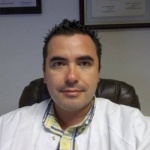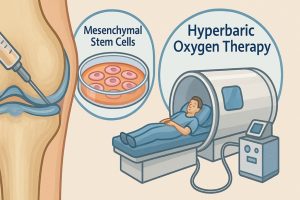 By: Dr. Elton Luis Gómez Ríos, Regenerative Medicine Specialist.
By: Dr. Elton Luis Gómez Ríos, Regenerative Medicine Specialist.
Knee osteoarthritis is one of the most prevalent musculoskeletal conditions worldwide and a leading cause of chronic pain and disability. Beyond limiting mobility, it significantly reduces quality of life, especially in adults. For decades, conventional treatments—such as anti-inflammatories, injections, and physical therapy—have mainly focused on managing symptoms, offering no real solution to halt or reverse cartilage degeneration. In this context, regenerative medicine has emerged as a promising alternative, aiming not just to alleviate pain but to foster actual tissue repair.
Among its most innovative approaches is the use of mesenchymal stem cells (MSCs), which can be obtained from bone marrow, adipose tissue, or umbilical cord tissue. These cells have the remarkable ability to differentiate into chondrocytes, osteoblasts, and fibroblasts, directly contributing to cartilage and bone repair. Moreover, MSCs secrete growth factors, cytokines, and exosomes that provide anti-inflammatory, immunomodulatory, and regenerative effects, creating a healthier environment for joint recovery.
Clinical outcomes are encouraging. Patients receiving intra-articular MSC injections have reported significant pain reduction, improved mobility and strength, and even MRI evidence of cartilage thickening. These benefits not only improve daily functionality but also slow disease progression, often delaying or reducing the need for knee replacement surgery—an invasive and costly procedure.
On the other hand, hyperbaric oxygen therapy (HBOT) has proven to be a powerful therapeutic tool across several medical fields. By delivering 100% oxygen at pressures between 2.0 and 2.5 ATA, HBOT dramatically increases tissue oxygenation. This process promotes the formation of new blood vessels, stimulates fibroblast and osteoblast activity, reduces oxidative stress, and exerts strong anti-inflammatory effects. In short, HBOT prepares and optimizes the biological environment for healing processes to occur more effectively.
 The true innovation arises when these two therapies are combined. MSCs and HBOT act synergistically to amplify each other’s benefits. HBOT reduces hypoxia and oxidative stress in the joint, creating optimal conditions for MSCs to survive, multiply, and release regenerative factors. Meanwhile, research shows that MSCs exposed to hyperbaric oxygen increase their secretion of bioactive molecules, resulting in a dual regenerative stimulus. In clinical practice, this translates into faster pain relief, greater functional improvement, and more sustained results over time compared to isolated therapies.
The true innovation arises when these two therapies are combined. MSCs and HBOT act synergistically to amplify each other’s benefits. HBOT reduces hypoxia and oxidative stress in the joint, creating optimal conditions for MSCs to survive, multiply, and release regenerative factors. Meanwhile, research shows that MSCs exposed to hyperbaric oxygen increase their secretion of bioactive molecules, resulting in a dual regenerative stimulus. In clinical practice, this translates into faster pain relief, greater functional improvement, and more sustained results over time compared to isolated therapies.
The future of medicine lies in such integrative approaches, where cellular science and advanced biomedical technologies work together to address conditions long considered irreversible. Knee osteoarthritis—historically viewed as a progressive, degenerative disease—may now be approached with a new perspective: one of regeneration and hope.
In conclusion, the combination of mesenchymal stem cells and hyperbaric oxygen therapy represents a cutting-edge, effective strategy for treating knee osteoarthritis. This approach not only alleviates symptoms but also promotes cartilage repair and extends the functional life of the joint. Incorporating this combined therapy into controlled clinical protocols opens the door to comprehensive, safe, and long-lasting treatments—bringing real hope to patients who have long suffered from this debilitating condition.
Dr. Elton Luis Gómez Ríos is a physician specializing in regenerative medicine and hyperbaric oxygen therapy. With extensive experience in musculoskeletal disorders, he has pioneered combined therapies to improve patients’ quality of life. He is passionate about advancing evidence-based treatments that bridge innovation and patient care.
📩 Contact: biohipercell@hotmail.com


